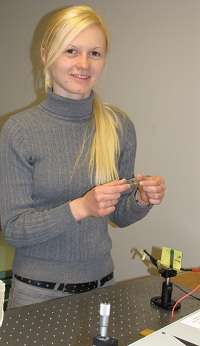SDSU graduate student generates electricity from windows

Windows may one day generate electricity to heat and cool buildings, thanks to research done at the South Dakota State University Center for Advanced Photovoltaics.
Window glass has tinting to filter the light so it's not too bright inside a commercial building, explained electrical engineering graduate student Anastasiia Iefanova.
But if she can replace the tinted glass with a transparent thin film solar cell, the light that the tinting now reflects could be absorbed and converted to electricity.
However, conventional solar cells are opaque, not transparent. Iefanova said, "I had to make it a transparent device that would still transport an electric charge."
The Fulbright scholar from Ukraine did the research as part of her master's degree, which she completed in May. Her adviser is associate professor Mahdi Farrokh Baroughi of electrical engineering.
To develop devices that will let light into the building, she focused on using a dye-sensitized solar cell, which has a potential to be semi-transparent. But she had to figure out how to make the back electrode of such solar cells transparent.
Iefanova had experience with solar panels for space destinations through graduate study at the National Aerospace University in Ukraine. "I came from big sizes to very small sizes," she explained, referring to the microscopic-sized materials developed in the SDSU photovoltaics program.
After trying different techniques, Iefanova developed an inexpensive method to spray coat nanoparticles of platinum onto the FTO glass. "It looks transparent," she said, like tinted glass, but the new thin film is able to transport a charge to the same extent as an opaque platinum thin film would.
"It was very simple," Iefanova said, and consequently the fabrication costs will be low when this technique is applied to a large surface, such as the window of a commercial building. The spray coating uses less than one-tenth of the material and thus reduces the cost by more than 90 percent when compared to the conventional sputtered coating method, she explained.
Her final step was to evaluate how efficient a device made out of this material might be. Iefanova said, the efficiency was comparable to that of the more expensive, nontransparent version.
"This was exciting and surprising," Iefanova said. Iefanova presented her findings at the Material Research Society Symposium last year and Photovoltaic Specialist Conference this year.
"Anastasiia is a formidable researcher and has done very good work," Baroughi said. He expects her to be able to publish two journal papers based on her research work.
Iefanova finds it helpful to work in a group research setting provided through the photovoltaics program. "Working in a group is more helpful than working alone," she said, about being able to brainstorm and discuss ideas with her colleagues.
Though her master's work is done, her days at SDSU are not—she plans on returning to SDSU for doctoral work in the photovoltaics and energy systems program.
Provided by South Dakota State University




















